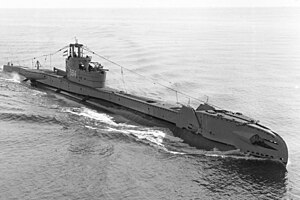HNLMS Zwaardvisch (P322)
 HNLMS Zwaardvis during her post-war service
| |
| History | |
|---|---|
| Name | HMS Talent |
| Builder | Vickers Armstrong, Barrow |
| Laid down | 13 October 1942 |
| Launched | 17 July 1943 |
| Fate | Transferred to the Royal Netherlands Navy on 23 March 1943 |
| Name | HNLMS Zwaardvisch |
| Commissioned | 23 November 1943 |
| Decommissioned | 11 December 1962 |
| Renamed | Zwaardvis in 1950 |
| Fate | Sold for scrapping 12 July 1963 |
| General characteristics | |
| Class and type | Zwaardvisch-class submarine |
| Displacement |
|
| Length | 276 ft 6 in (84.28 m) |
| Beam | 25 ft 6 in (7.77 m) |
| Draught |
|
| Propulsion |
|
| Speed |
|
| Range | 4,500 nmi (8,300 km; 5,200 mi) at 11 kn (20 km/h; 13 mph) surfaced |
| Test depth | 300 ft (91 m) max |
| Complement | 61 |
| Armament |
|
HNLMS Zwaardvisch (S814) was the
Design and description
Zwaardvisch was 276 ft 6 in (84.28 m) long, had a beam of 25 ft 6 in (7.77 m) and a draught of 12 ft 9 in (3.89 m) forward and 14 ft 7 in (4.45 m) aft. She displaced 1,290
Operational history


The submarine was
Under the command of Lieutenant Hendrikus Goossens, Zwaardvisch moved to
Assigned to the British 8th Submarine Flotilla, Zwaardvisch operated out of
The final months of the war were spent in the South China Sea attacking Japanese merchantmen, and patrolling the Lombok Strait. In February 1945, Zwaardvisch was attacked and damaged by a Japanese aircraft and had to return to Fremantle the following month for repairs. Once these were complete, she returned to the Java Sea under the command of Lieutenant Jan van Dapperen, where she made further attacks on Japanese merchantmen throughout April and May before returning to Fremantle to repair faulty communications and weapons systems. Following the surrender of Germany in early May, the submarine returned to Britain to undertake further repairs in Dundee before transferring to Rotterdam in August 1945.[3]
Apart from a voyage to the
References
Citations
- ^ "T class Submarines". Uboat.net. Retrieved 12 July 2015.
- ^ "HMS Talent". Uboat.net. Retrieved 12 July 2015.
- ^ a b c "Dutch Submarines: Zwaardvis". dutchsubmarines.com. Archived from the original on 2 April 2015. Retrieved 12 July 2015.
- ^ a b Hurst 2001, p. 125.
- ^ "HNMS Zwaardvisch". Uboat.net. Retrieved 12 July 2015.
- ^ Royal Australian Navy. "German U-Boat Operations in Australian Waters". www.navy.gov.au.
Bibliography
- ISBN 978-1-86176-281-8.
- Hutchinson, Robert (2001). Jane's Submarines: War Beneath the Waves from 1776 to the Present Day. OCLC 53783010.
- Hurst, Doug (2001). The Fourth Ally: The Dutch Forces in Australia in WWII. Chapman, Australian Capital Territory: D. Hurst. ISBN 9780957925205.
